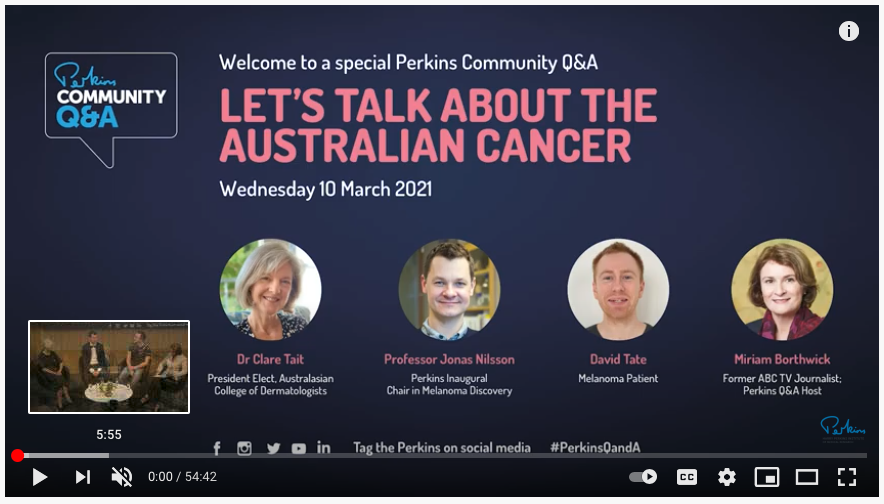
A special Perkins Community Q&A, “Let’s Talk About the Australian Cancer”, was presented to a full (covid-safe) auditorium and streamed on Facebook Live 10th March 2021. This panel discussion led by inaugural Perkins Chair of Melanoma Discovery, Professor Jonas Nilsson included special guests discussing how melanoma impacts the WA community, and what experts are doing to further our understanding of the disease.
While Australia has one of the highest rates in the world of the deadly skin cancer, melanoma, Sweden had one of the world’s experts in researching it, until recently.
Professor Jonas Nilsson has come to Perth from a leading cancer centre in Gothenburg, Sweden to take up the position of the inaugural Chair of Melanoma Discovery at the Harry Perkins Institute of Medical Research.
In a panel discussion with 30-year-old Melanoma patient, David Tate and Dermatologist, Dr Clare Tait, Jonas talked about the advances in research that are tackling the cancer which is so present here that its dubbed ‘the Australian cancer’.
“I think it’s a remarkable time to be a Melanoma researcher because we’ve been able to really see what research can do for a disease that very few ever thought was possible to treat. Melanoma is now the poster boy for two types of treatment,” he said.
These treatments are Immunotherapy – where the patient’s own immune system is harnessed to attack the cancer cells, and targeted therapy – developed after scientists investigated the changes occurring in the genetic material in cancer cells that activated signals telling the cell to start dividing uncontrollably.
“Around 2002 it was discovered that this genetic material was encoded into a protein called B-RAFF and this protein becomes overactive and starts telling the cell to divide and divide and divide,” said Jonas. “So then the obvious idea would be, if we can find a way to generate a small molecule that can combine with this activated protein and stop it from telling the cell to divide, then we would have a therapy.”
This was developed, and along with immunotherapy is now a standard treatment for people with metastatic melanoma.
“It was remarkable! There were case studies where patients with metastases all over the body would be given a pill with this B-RAFF inhibitor and the tumours just melted away.”
For David, that is exactly what happened. His tumours that he could feel on his back literally shrank and disappeared within two weeks.
“Within a week of my first treatment I noticed lumps disappearing,” David said.
While the two treatments are having an enormous impact on some patients, not all respond as well, which is why Jonas is now setting up a bio bank in Perth to collect tumours and tissue, particularly from those patients.
“Our team is investigating how we can alter immune cells outside a patient’s body and then reintroduce enhanced immune cells in large numbers to help that person fight off the disease,” said Jonas.
Jonas’ appointment in Perth as the inaugural Chair of Melanoma Discovery was in part thanks to a group of dedicated supporters, who were moved to leave a legacy to recognise the wishes of 27-year-old young golfer, Scott Kirkbride, who lost his life to melanoma in 2004.
Scott’s mother Vonnie Kirkbride said, “Scott hoped that his diagnosis of melanoma would help in some way in the future and we felt we needed to fulfil his wishes and try and do whatever we could.”
In a heartfelt discussion at the Perkins, Dr Clare Tait acknowledged that melanoma was a cancer that affected young people as well as older patients.
“Sun exposure is a risk factor, as is having a close relative with melanoma,” Clare said.
She described the ABC of what to look out for.
- A is for asymmetry – Check if a mole is growing and becoming irregular in shape
- B is for border – Get checked if a mole develops a curvy or irregular edge
- C is for colour – Most moles are one colour, light brown or dark brown or black, even blue but get checked if they change from their usual colour
- D is for diameter – Get checked if it increases in diameter
Clare also advises using a broad spectrum 50 SPF sunscreen, and always see your GP if concerned.
<watch the event recording here>
